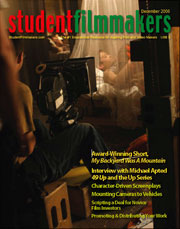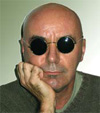Music, Sound, and Audio Technology
| Loopularity & Exploring the Intersection of Sound and Moving Image: Mapping Musical Concepts to Visual Thinking By Staff posted Oct 16, 2009, 11:53 |
|
Check out this article in the print edition of StudentFilmmakers Magazine, December '06. Click here to get a copy and to subscribe >>
 Loopularity
& Exploring the Intersection of Sound and Moving Image:
Loopularity
& Exploring the Intersection of Sound and Moving Image:
Mapping Musical Concepts to Visual Thinking
by Maurice Methot
Music as a metaphor brings many new resources to the table. One of these is the concept of the loop. In a musical context, the idea of the loop is as fundamental and familiar as do re mi. Whether it�s a funky sampled drumloop breakbeat or an ostinato from Bach�s Suite for Solo Cello, the cycle is a device that provides the power of repetition, which establishes and informs a significant dimension of our cognitive experience of music.
Repetition figures differently in the visual world. Because our immediate perception of real time is not circular (or loopular if you will), the entrance of detectable levels of repetition can act as noise or disturbance to the normal flow of time. In the non-linearity of a dreamscape montage (analogous to a musical fugue) where time is presented as distorted, the loop can add to the uncanny nature of the experience. When the visual material is abstract, repetition becomes a kind of plausible movement within the context of the piece � a geometric motion � as demonstrated in early abstract films by artists like Fernand Leger and Hans Richter. If commonplace and non-abstract objects are subjected to repetitive movements, they become abstract and less real.
| Post Your Comments & Questions about this topic here >> |
Any element in the visual domain can can be mapped to the idea of loopularity. For example, a visual loop can be simple repetition:
Repetitive cycling from frame N ----> frame N + X
But this is only one kind of loop restricted to the temporal domain. Color cycling is another classic form of video manipulation that maps a repeating cyclical progression through a range of RGB values and applies the result to the image or portion of the image. This is a classic device often used in combination with chroma or luma keying for psychedelic effect. All of these procedures have been available in analog video edit suites for years and are carried into the digital visual dimension through such multimedia applications such as Macromedia Director and Flash.
A true synthesis of sound and image would provide for the formal components of the one to interact freely and playfully with the other. Live audio/video mixing is different from in-the-timeline editing in that it happens on the fly and in realtime. This performance component, like musical improvisation, brings out the opportunity for jamming and playing around with things like loopularity.
It�s as easy as pie to copy and duplicate a clip in the editing timeline ad infinitum. In fact, I would suggest this as a good exercise: try loading up a stack of video layers, filling these with video loops, and mixing them in various combinations of transparency. This is a great way to experiment with thinking in painterly terms. The pure and simple sensual delight of color, light, and chance combination as applied to sound are the stuff of musical explorations by composers from Mozart to Cage.
To experiment with repetition in the temporal domain requires nothing more than grabbing and repeat-pasting random sections without even thinking about content. This reminds me much of making tape loops and running them on my old analog reel-toreel. (Repeat after me: �number nine...number nine...number nine...number nine...� etc.) Minimalist composers like Steve Reich and Philip Glass have based much of their music process on systematic explorations of the loop in terms of time and tone. Visual repetition, like sonic repetition, can be used to bring about trance states, humor, meditation and introspection, metaphysical pause, and other forms of altered consciousness. The influence of live video mixing and electronic music on contemporary advertising media goes beyond the merely trendy and suggests that a culture drawing from music videos and immersive gaming has a real need for pure sonic and video stimulation.
Cut and paste video editing can lack the live and in the moment dimension of live musical performance. Here the art of live video performance enters the equation. The tools of the live video artist (the VJ) can seem at first glance a bit more esoteric than familiar tools like Final Cut. These tools can be based on digital versions of the analog video switcher/mixer/special effects generator.
The VJ is to video as the DJ is to beats. If you look into the history of video as a performance art you find a rich history of creative innovators, from Nam June Paik to Emergency Broadcast Network. Today, numerous tools are available for the performance of live video mixing and manipulation. Consoles and software such as Motion Dive and MAX/MSP/Jitter allow artists to manipulate video in musical terms, and create new tools to explore the synthesis of image, time, movement, repetition, and sound in improvisational gestures that allow for a more fully immersive and poetic media experience.
As the Talking Heads once said �Stop making sense!� Real formal experimentation in the organization of sound and image encourages you to disengage from the process of storytelling in the usual sense. The benefit is that these experiments can open new dimensions in your work. Music - that most abstract of languages - can be used not only on a macro level (movements, sections, etc.) but a micro level as well (gestures, phrases, cycles, and visual counterpoint). If you bring live performance into the mix, you have the richness of free improvisation and chance � a kind of visual fourth stream jazz.
The use of music as mere accompaniment to �the visual� works against creative opportunities for a deeper synthesis of the sonic and the visual. It comes as no surprise that many such moments occur in segments where the visual is most abstract (Busby Berkeley�s geometric dance productions, Kubrick�s stargate sequence, etc.). But filmmakers like Michel Gondry, David Lynch, Mark Frost, and many more have brought about remarkable moments in narrative films where sound, image, movement, and the associative and abstract power of music seem to fuse into truly timeless moments of real synthesis. This synthesis can be a place of beauty - like music for the eyes and ears.
| Post Your Comments & Questions about this topic here >> |
 Maurice
Methot is a musician and media artist whose live performances range from
C.B.G.B.�s to the Moscow Conservatory of Music. He lives in Providence,
RI, and is currently an Associate Professor of Visual and Media Arts at
Emerson College in Boston where he teaches classes in Media Production,
New Media, and the Art of Noises. Maurice
Methot is a musician and media artist whose live performances range from
C.B.G.B.�s to the Moscow Conservatory of Music. He lives in Providence,
RI, and is currently an Associate Professor of Visual and Media Arts at
Emerson College in Boston where he teaches classes in Media Production,
New Media, and the Art of Noises. |
This article may not be reprinted in print or internet publications without express permission of StudentFilmmakers.com. The above photos may not be copied or reproduced.
Check out this article in the December 2006 print edition of StudentFilmmakers
magazine, page 36.
Click
here to get a copy of the December 2006 Edition, so you can read
and enjoy all of the excellent articles inside.
About StudentFilmmakers Magazine and StudentFilmmakers.com
Learn about the Latest, Cutting-Edge Technologies and Techniques at StudentFilmmakers.com
and StudentFilmmakers Magazine, the #1 Educational Resource for Film
and Video Makers covering various topics with special focus on: Development,
Pre-Production, Production, Post Production, Distribution. Article categories
include: Cinematography, Lighting, Directing, Camerawork, Editing, Audio, Animation,
Special FX, Screenwriting, Producing, and more. Watch, upload, and share your
films and videos in the video section at: networking.studentfilmmakers.com/videos.
Network and connect with filmmakers around the globe using the Filmmakers Social
Networking Site at: networking.studentfilmmakers.com.
Share your ideas, post your questions, and find answers in the online interactive
forums moderated by experts at: www.studentfilmmakers.com/bb.
StudentFilmmakers.com (www.studentfilmmakers.com)
also produces and hosts film, video, and screenwriting festivals and contests,
as well as educational workshops and seminars. Get the magazine, read the e-newsletter,
and participate in the online portal and resource with free tools for film and
video makers of all levels around the globe. With the technology changes
coming faster and faster, we are all students.
StudentFilmmakers magazine would like to hear from you!
Click here to
share your comments and feedback about the magazine, monthly editions, your
favorite articles, and your favorite topics.
We always welcome and appreciate your Reader Comments. View them here, and send yours to the editorial team today!